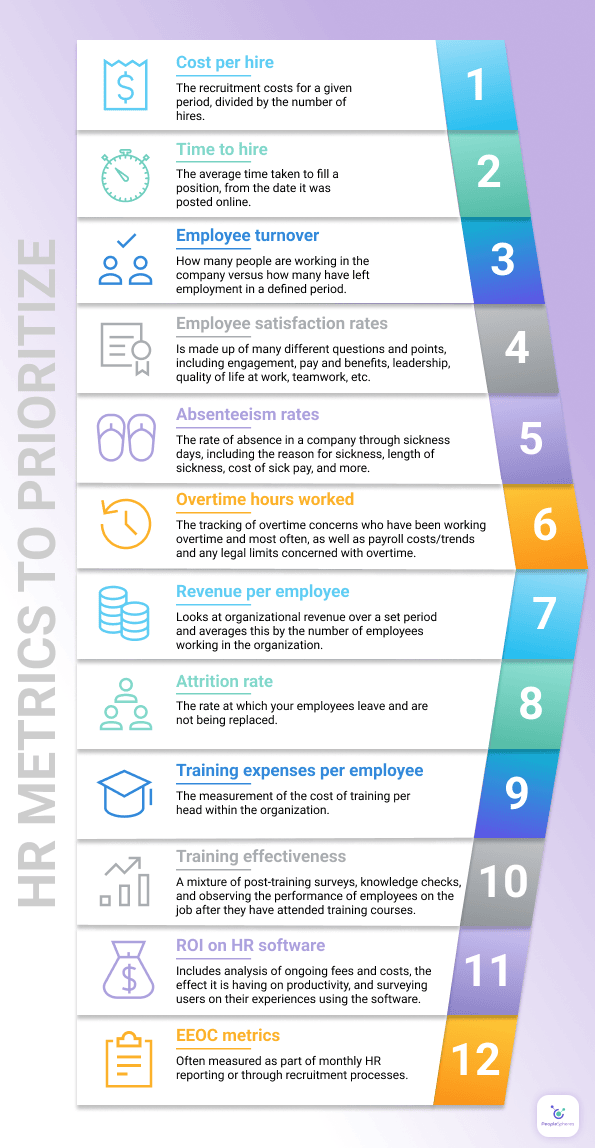
Human Resources (HR) is a hugely data-driven division of any organization. Even if it doesn’t always conjure up images of reporting and analytics. HR metrics are essential for any business as they can contextualize a very hard-to-measure and expensive aspect of the organization: its people.
A key option being implemented more often nowadays is HR technology to provide organizations with this data more accessible.
In a study by ISG, they studied how successful organizations have been in HR technology and service delivery. It was shown that only 28% have been very successful at establishing enterprise-wide HR metrics. Only 45% reported that they were not successful at all.
To understand more the importance of HR metrics. This article defines HR metrics, why you should track them, and the key HR metrics you should be monitoring.
Related articles:
Which KPIs to optimize for HR management?
Why Your Company Needs SMART HR Goals
.
What are HR Metrics?
HR metrics refer to the data and measurement of what happens in HR. HR measurement quantifies what HR is doing, as well as the performance of employees.
These are extremely important measurements as they offer a trackable and measurable way of understanding the company’s financial health. The performance management of the HR department and the happiness and productivity of the employees can also be measured. HR metrics cover many areas of HR, including recruiting and retention, employee engagement, payroll, absenteeism, staffing, leadership, learning and development, and benefits.
HR KPIs
KPIs, or key performance indicators, are critical indicators of progress toward the desired outcome. Today, tracking KPIs for HR has become an important part of HR reporting. There are different KPIs depending on what it is that your HR department wants to measure and optimize. For example, there are KPIs for leave and absence, employee training, payroll, and employee productivity.
The emergence of new HR KPIs that optimize HR management means more objective decision-making. It can also mean better involvement from employees, a complete vision of company health, and more accurate budgeting.
By using and analyzing HR KPIs, you can implement new, more efficient, HR strategies. Choosing the right HR KPIs for your business can be complicated and confusing. Below are some characteristics of high-quality KPIs:
1. Clear objective
2. Measurable
3. Reachable
4. Relevant
5. Connected to the desired result
6. Understandable
7. Actionable
Why You Should Track HR Metrics
HR has traditionally been considered to be a data-free organizational division, but the reality is that a large part of HR operations is concerned with the measurement and analysis of data. Tracking HR measurements quantify the role of HR as a critical business partner to the wider organization.
This is the way to have better workforce management where you will provide competencies to the new hires and obtain data that will provide clarification of what the company needs.
HR Reporting for Executives
Senior HR leaders make use of HR metrics by using them as the basis for key decision-making. HR metrics also inform the rest of the team on what HR is focusing on. Furthermore, they can be used for backing up the main challenges and opportunities HR faces.
Often, HR metrics can be summarized into dashboards which are perfect to share with management. If done well, they can retain important information while communicating it in simplified, easy-to-digest ways.
HR Strategy
HR leaders can interpret HR measurements to understand priorities, both in the long and short term. Before strategic meetings, HR leaders might wish to review their organization’s HR metrics to look at what is going well. This can help them decide what might need a push. This information is then worked into long-term actions and business goals which shape the HR strategy for the coming year, or beyond.
Prioritizing the Employee Experience
HR measurements are not just useful for business strategy. They can also be used to understand and analyze how employee perceives their workplace. The best example of a metric that achieves this is employee engagement.
Data from this measurement – usually obtained through engagement surveys – can be reviewed and taken back to employees to deep dive into survey answers. The outcome of this can be employee experience interventions developed in line with real-time data. These can be a lot more meaningful to the employees and their happiness. This will provide top talent to continue working at their highest potential and retaining them as you will provide a clear separation between your company and the others.
When it comes to friction in the employee experience, many employers feel uncertain with remote working:
Hybrid and remote employees are 40% more likely to experience high levels of work friction
Gartner study from 2022
This is because of the uncertainty and how fast technology is evolving.
For this reason in order to improve the employee experience, there has to be an ease in which organizations implement these strategies. This can be easily done through the help of certain tools such as an HR system. These systems provide extra security, organization, and employee management.
Which HR Metrics Should You Prioritize?
There is a whole suite of HR measurements for HR leaders to consider. Below, we list the top metrics in HR:
1. Cost per Hire
Cost per hire is the reporting of recruitment costs for a given period, divided by the number of hires. This HR measurement is critical as it will help recruiters understand the effectiveness of talent acquisition interventions, and where and how costs can be distributed going forward. Analysis of cost per hire is important as some roles will inevitably cost more to recruit for, such as senior roles or positions experiencing a skills shortage.
2. Time to Hire
Time to hire (or time to fill) is the average time taken to fill a position, from the date it was posted online. Typically, time to hire stops ‘counting up’ as soon as the contract of employment is signed, although some organizations only consider a role hired when the person is on their first day of employment.
Time to hire isn’t exactly a metric concerned with how quickly you are hiring (recruitment should rarely be rushed). Rather, it is used more for the recruiter or supervisors to continue understanding the efficiencies and processes behind a recruitment process.
3. Employee Turnover
Employee turnover is the measurement of how many people are working in an organization versus how many have left employment in a defined period. This classic HR measurement is time-tested and tells an HR team a lot about retention, organizational health, and reasons for leaving.
Employee turnover is split into voluntary and involuntary turnover. Voluntary turnover refers to people who leave of their own accord – i.e., a simple resignation to do with finding a new job, dissatisfaction with work-life balance, or personal reasons. This in itself is a major problem. Using predictive models, you can predict turnover before it happens and implement proactive retention strategies to mitigate the risk.
Based on a study by McKinsey in 2022, “40% of workers globally say that they might leave their jobs in the future”. This is why it is important to keep this as an HR metric to pay attention to.
Involuntary turnover refers to those people who are asked to leave, such as employees who do not pass their probation period, or dismissals due to underperformance or misconduct.
There can be other categories of turnover, such as reasons which are neither strictly voluntary nor involuntary (retirement or redundancy are two examples). Internal transfers or promotions sometimes referred to as ‘positive turnover,’ are not seen to be harmful to the business. For this reason, positive turnover is sometimes omitted from employee turnover reporting.
4. Employee Satisfaction Rates
Employee satisfaction rates often gleaned from engagement results, will tell you a great deal about how employees are feeling at work. This HR measurement is made up of many different questions and points, including overall engagement, pay and benefits, leadership, quality of life at work, teamwork, and standalone questions.
This metric must be treated as feedback, with the data discussed in teams and used to map out actionable improvements to the employee experience.
5. Absenteeism Rates
Absenteeism measures the rate of absence in an organization through sickness days, including the reason for sickness, length of sickness, cost of sick pay, as well as any emerging patterns of sickness regarding individual employees. As such, this is an important HR measurement for many reasons, such as tracking employee conduct, welfare, and payroll cost. Absenteeism can also include the tracking of other absences, such as unpaid leave or vacation days.
6. Overtime Hours Worked
Tracking overtime is critical, especially nowadays when staff shortages are more commonplace and overtime payments are frequent and costly. The tracking of overtime concerns who have been working overtime and most often, as well as payroll costs/trends and any legal limits concerned with overtime.
7. Revenue per Employee
Revenue per employee looks at organizational revenue over a set period and averages this by the number of employees working in the organization.
This is a useful measure in terms of understanding productivity and efficiency, as well as aligning HR measurement with top-level business metrics. Revenue per employee will require thorough analysis to understand why it is at its current level. Long-term revenue per employee trends can be used to understand if there is a need to downsize or ‘rightsize’ the business or add headcount to cope with the workload.
8. Attrition Rate
Attrition rate, also referred to as churn rate, measures the rate at which your employees leave and are not being replaced. The success of your company is dependent on keeping your workers. Calculating and analyzing attrition rate allows you to identify how many workers are left over a specific time period, and their reason for resignation, such as voluntary or involuntary.
9. Training Expenses per Employee
Training expenses per employee are useful for analysis of the cost of training per head. This can help organizations understand how to allocate training funds, and if any adjustment to this budget is needed. This HR measurement is best used in conjunction with other training metrics but can be especially useful for analyzing how much importance an organization places on learning and development, compared to its competitors.
10. Training Effectiveness
Training effectiveness is measured using a mixture of post-training surveys, knowledge checks, and observing and measuring the performance of employees on the job after they have attended a particular training course. This is a very useful HR measurement to help practitioners understand the best ways to train people, and if something isn’t working, whether an alternative approach can be considered.
Sometimes, the outcome of analyzing training effectiveness is that the right things are being trained, but the feedback suggests that a different training medium (in order to adapt to different learning styles) is a better way to go.
11. Return on Investment of HR Software
HR software can be a huge cost outlay for an organization, so it pays to understand the return on investment for this software. This could be as simple as comparing the above HR measurements before and after you implemented the software, but can also include an analysis of ongoing fees and costs, the effect it is having on productivity, and surveying users (such as the HR team or line managers) on their experiences using the software.
12. Equal Employment Opportunity Commission (EEOC) Metrics
EEOC has become a very important part of HR in recent years. In some countries, it’s a legal requirement to review and report equal opportunity metrics, however doing so – often as part of monthly HR reporting or through recruitment processes – is also important to understand diversity and equality in your organization.
EEOC metrics can add value to a business by ensuring there is an equitable mix of people which can bring numerous benefits to a team in terms of different perspectives, cultural diversity, employer value proposition, and candidate attraction.

How to Go About HR Metric Measurement
Setting up HR metrics needs a lot of careful planning and thought. Business leaders must consider a broad suite of metrics to begin with, and adapt this as the organization evolves, focusing more on specific ones if needs be. HR metrics are formed as part of organizational and departmental HR strategies, so must be agreed upon by senior leaders, and then carefully communicated and trained to all levels of the organization, especially line managers and the HR team.
To do this, you must work HR measurements into business goals and organizational targets. These metrics are then reported frequently and consistently to leadership. This not only focuses the organization on the achievement of HR goals, but also demonstrates to senior leadership the progress of the HR profession and its alignment with broader organizational goals.
HR Smart Goals
SMART goals are used as a goal-setting technique that can be used to strategically improve the goal-setting process. It can help achieve long-term success of a company.
The word “SMART” in SMART goals stands for approaches that should be taken to optimize goal-setting:
S: specific, M: measurable, A: attainable, R: relevant, T: time-bound
When applied to human resources, SMART HR goals increases focus and employee productivity as it gives employees a clear vision while encouraging them to get their work tasks done. Smart HR goals are also associated with higher levels of employee retention, employee engagement, improved talent acquisition, and decreased recruitment costs.
HR Reporting Tools
HR measurements are best tracked on HR reporting tools. These tools can feed from various HR systems and compile data and information. HR platforms, such as PeopleSpheres, bring together various HR processes and can simplify the reporting process. This enables data to be tracked on one system and reported out accordingly. Alternatively, an organization’s HR function might include a role or responsibility completely focused on HR data and reporting, coordinating all data and distributing it accordingly.
HR Dashboards
HR dashboards build on HR reporting, communicating and presenting HR data and benchmarking in a clear and consistent way. Some HR platforms also offer HR dashboard functionality, such as PeopleSpheres. HR dashboards are especially useful for presenting information to people less acquainted with HR processes, such as senior organizational leadership (who also might be too busy to spend time reading through long reports) or for junior employees in attendance of meetings.
Although HR dashboards are great for transferring information, it is more than a communication tool: it enhances the employee experience. Employee dashboards allow both employees and managers to gain meaningful insight to support and guide strategic decisions. It enables you to keep track of employees’ performance reviews, compensations and benefits, and recruitment.
Conclusion
HR metrics are an essential part of a modern HR team. HR leaders often refer to themselves as HR business partners. They work alongside the business and supporting critical decisions with analytics and reports. Thus, the role of HR metrics in this is undeniable.
Knowing which HR metrics to use can be challenging and will depend on the nature of your business. Nevertheless, it helps to have a suite of different metrics which focus on different areas of HR. HR leaders should work these into goals that are set for managers and HR departments. They should also be analyzed through informative reporting, and presented in concise and clear dashboards. These should demonstrate to the entire organization the impact and benefits that a data-driven HR team can offer.



-360x360.jpg)
-640x380.jpg)

-640x380.jpg)